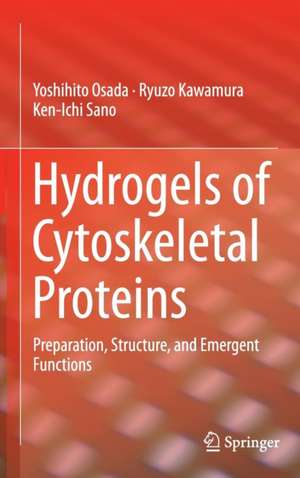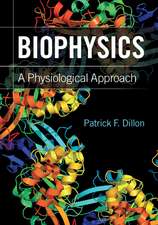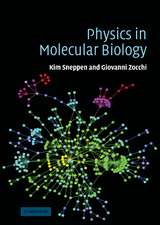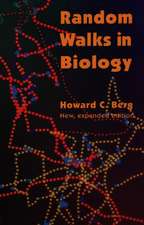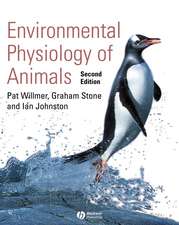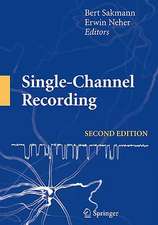Hydrogels of Cytoskeletal Proteins: Preparation, Structure, and Emergent Functions
Autor Yoshihito Osada, Ryuzo Kawamura, Ken-Ichi Sanoen Limba Engleză Hardback – 29 ian 2016
| Toate formatele și edițiile | Preț | Express |
|---|---|---|
| Paperback (1) | 630.43 lei 43-57 zile | |
| Springer International Publishing – 30 mar 2018 | 630.43 lei 43-57 zile | |
| Hardback (1) | 636.45 lei 43-57 zile | |
| Springer International Publishing – 29 ian 2016 | 636.45 lei 43-57 zile |
Preț: 636.45 lei
Preț vechi: 748.76 lei
-15% Nou
Puncte Express: 955
Preț estimativ în valută:
121.79€ • 127.47$ • 101.36£
121.79€ • 127.47$ • 101.36£
Carte tipărită la comandă
Livrare economică 31 martie-14 aprilie
Preluare comenzi: 021 569.72.76
Specificații
ISBN-13: 9783319273754
ISBN-10: 3319273752
Pagini: 79
Ilustrații: XII, 79 p. 39 illus., 35 illus. in color.
Dimensiuni: 155 x 235 x 6 mm
Greutate: 0.31 kg
Ediția:1st ed. 2016
Editura: Springer International Publishing
Colecția Springer
Locul publicării:Cham, Switzerland
ISBN-10: 3319273752
Pagini: 79
Ilustrații: XII, 79 p. 39 illus., 35 illus. in color.
Dimensiuni: 155 x 235 x 6 mm
Greutate: 0.31 kg
Ediția:1st ed. 2016
Editura: Springer International Publishing
Colecția Springer
Locul publicării:Cham, Switzerland
Public țintă
ResearchCuprins
Introduction.- Microtubules Gel.- Actin Gel.- Tropomyosin Gel. Conclusion.
Notă biografică
Professor Yoshihito Osada obtained his Bachelor’sdegree in chemistry from Waseda University, Japan, and received his Ph.D. inpolymer science from Moscow State University (supervisor: Prof. V.A. Kabanov).He began as a professor in 1992, then became the Dean and eventually the Vice President of HokkaidoUniversity, Sapporo, Japan. He was invited to be Deputy Director at the AdvancedScience Institute, RIKEN in 2007. He is currently a Senior Visiting Scientist atRIKEN and a professor emeritus at Hokkaido University.
Professor Yoshihito Osada is a pioneer of polymer gels. He developed artificial muscle systemsusing various functional gels such as Shape Memory Gel and Double Network Gelwith excellent mechanical performances. His current interests focus on highly-hierarchical protein gels with “emergent”muscle functions, nano-patterning of the gel, and electro-conductive gels.
Ken-Ichi Sanoreceived his B.S. degree in biologyfrom Osaka City University, Japan, in1993, and his Ph.D. degree in biophysics from Nagoya University, Japan, in2000. In 1994, he joined the International Institute for Advanced Research,Panasonic, and since 1999 he has worked for RIKEN, Harima Institute at SPring-8.Since 2003 he has been with the Department of Protein Engineering, CancerInstitute, Japanese Foundation for Cancer Research, wherehe studied interfacial molecules between biomaterials and inorganics. In 2008,he joined the Molecular and System Life Science Unit, Advanced Science Institute,RIKEN as a Contract Researcher, and became Deputy Unit Leader in 2009 where hestudied hydrogels of cytoskeletal proteins. In April 2011 he joined the Department of Innovative Systems Engineering, Nippon Institute of Technology asan Associate Professor. His current research interests include cellular drugdelivery systems and evaluation of antidepressant agents using novel models.
Ryuzo Kawamurawasborn in Nara, Japan, in 1980. He obtained his Bachelor’s degree inbioengineering from Tokyo Institute of Technology, Japan, in 2005 and receivedhis Ph.D. in polymer science from Hokkaido University, Japan(supervisor: Prof. J.P. Gong) in 2008. He did postdoctoral research at RIKENand at the National Institute of Advanced Science and Technology (AIST). Currently,he is an Assistant Professor in Department of Chemistry, Saitama University,Japan.
In 2009, he joined the Molecular and System Life Science Unit, AdvancedScience Institute, RIKEN. There he developed the Multi-scale HierarchicalSupra-Macromolecular Gels (MHSMG) as a new type of material. His currentresearch interest is in coordinative and mesoscale functions of thecytoskeletal and motor proteins with both viewpoints of material science andbiology.
Professor Yoshihito Osada is a pioneer of polymer gels. He developed artificial muscle systemsusing various functional gels such as Shape Memory Gel and Double Network Gelwith excellent mechanical performances. His current interests focus on highly-hierarchical protein gels with “emergent”muscle functions, nano-patterning of the gel, and electro-conductive gels.
Ken-Ichi Sanoreceived his B.S. degree in biologyfrom Osaka City University, Japan, in1993, and his Ph.D. degree in biophysics from Nagoya University, Japan, in2000. In 1994, he joined the International Institute for Advanced Research,Panasonic, and since 1999 he has worked for RIKEN, Harima Institute at SPring-8.Since 2003 he has been with the Department of Protein Engineering, CancerInstitute, Japanese Foundation for Cancer Research, wherehe studied interfacial molecules between biomaterials and inorganics. In 2008,he joined the Molecular and System Life Science Unit, Advanced Science Institute,RIKEN as a Contract Researcher, and became Deputy Unit Leader in 2009 where hestudied hydrogels of cytoskeletal proteins. In April 2011 he joined the Department of Innovative Systems Engineering, Nippon Institute of Technology asan Associate Professor. His current research interests include cellular drugdelivery systems and evaluation of antidepressant agents using novel models.
Ryuzo Kawamurawasborn in Nara, Japan, in 1980. He obtained his Bachelor’s degree inbioengineering from Tokyo Institute of Technology, Japan, in 2005 and receivedhis Ph.D. in polymer science from Hokkaido University, Japan(supervisor: Prof. J.P. Gong) in 2008. He did postdoctoral research at RIKENand at the National Institute of Advanced Science and Technology (AIST). Currently,he is an Assistant Professor in Department of Chemistry, Saitama University,Japan.
In 2009, he joined the Molecular and System Life Science Unit, AdvancedScience Institute, RIKEN. There he developed the Multi-scale HierarchicalSupra-Macromolecular Gels (MHSMG) as a new type of material. His currentresearch interest is in coordinative and mesoscale functions of thecytoskeletal and motor proteins with both viewpoints of material science andbiology.
Caracteristici
Contains up-to-date interdisciplinary research on biomimetic materials for artificial muscle and organic actuators Explains ionic and reactive gel material models of the cell and intracellular gel-like materials which contain reactive macromolecules, ions, and water Describes future material prospects for zoomorphic and anthropomorphic robots, sensing tools and motors for mimicking haptic muscles, and the expression of physico-chemical equations for mechanical awareness Includes supplementary material: sn.pub/extras
